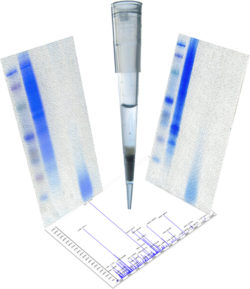Proteomics
 Our ability to examine the “proteome” i.e. the complement of proteins making up any particular organism or specific cellular or sub-cellular system, has been revolutionised through the tremendous advances made in mass spectrometry and protein sequencing and also the knowledge arising from major genome sequencing initiatives and bioinformatics resources. Proteomics is essentially the large-scale analysis of the proteome. Proteomics offers complementary insights to other ‘omics, integrating genetic and epigenetic factors, and reflecting the functional impact and complex interplay of changes in multiple cellular pathways, often consequent on post-translational modifications which are not evident at the gene level. The complexity compared with the genome results in major inherent challenges associated with analysing very large numbers of proteins with a wide range of post-translational modifications, spanning a wide range of abundances and with no PCR-equivalent amplification process. Such studies really only provide a snapshot and of course proteomes are highly dynamic.
Our ability to examine the “proteome” i.e. the complement of proteins making up any particular organism or specific cellular or sub-cellular system, has been revolutionised through the tremendous advances made in mass spectrometry and protein sequencing and also the knowledge arising from major genome sequencing initiatives and bioinformatics resources. Proteomics is essentially the large-scale analysis of the proteome. Proteomics offers complementary insights to other ‘omics, integrating genetic and epigenetic factors, and reflecting the functional impact and complex interplay of changes in multiple cellular pathways, often consequent on post-translational modifications which are not evident at the gene level. The complexity compared with the genome results in major inherent challenges associated with analysing very large numbers of proteins with a wide range of post-translational modifications, spanning a wide range of abundances and with no PCR-equivalent amplification process. Such studies really only provide a snapshot and of course proteomes are highly dynamic.
There are now many “sub-specialities” either in terms of area or type of analysis and often overlapping such as clinical proteomics, chemical proteomics, peptidomics, glycoproteomics, and phosphoproteomics. In large-scale “shotgun” studies the aim is the sequencing of as many proteins as possible, often several thousand in a single sample, allowing an unbiased view of the biological system(s) being analysed. Prior fractionation is often employed to increase coverage, with sample comparisons identifying differences arising from experimental interventions for example. Alternatively proteomics studies may be targeted at specific proteins based on certain physicochemical properties or on interactions, for example following immuno-precipitation, to explore protein networks and identify interacting partners. A variety of quantitative approaches are now possible involving either label-free spectral methods or labels such as stable isotope labelling by amino acids in cell culture (SILAC or Super-SILAC) allowing differentiation by the mass spectrometer and comparison of samples. More recently with developments in multiple/selected reaction monitoring (MRM/SRM) approaches for proteins, mass spectrometry is also increasingly being used to measure multiplex panels of proteins, overcoming the lack of suitable immunoassays in some cases. Other technologies include two-dimensional gel electrophoresis , although not so widely used now, and a variety of array-based approaches using antibodies or other affinity binders.
In Leeds proteomics is being applied in many ways to provide insights into biological processes in a variety of systems including microbes, plants and humans and to understand the changes which happen in disease. The Clinical and Biomedical Proteomics group provide a service facility to support other groups interested in exploiting proteomics in their research (link to www.proteomics.leeds.ac.uk). The group’s particular interests lie in biomarker discovery and translation, identification of novel therapeutic targets and exploring the mechanisms underlying disease, with a focus on diseases affecting the kidney. Through participation in a large-scale international study in renal cancer (www.cng.fr/cagekid/), integrated proteogenomic approaches are also being explored.
